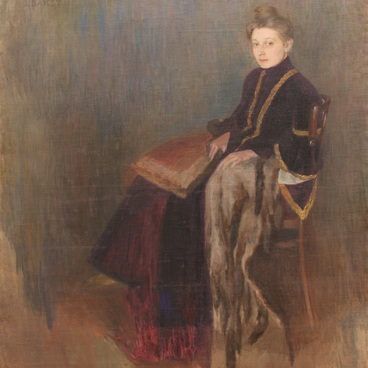Saint George the Victorious on a black horse
Время создания
The second half of 15th century
Размер
63,5x49,8 cm
63.5x49.8x2.7 cm
63.5x49.8x2.7 cm
Техника
Wood, tempera
1
Открыть в приложении#1

Unknown author
Saint George the Victorious on a black horse
#9
#2
The icon ‘Saint George the Victorious on a black horse’ was created in the second half of the 15th century in Novgorod. The Great Martyr George was among the most revered saints in ancient Russia. He lived in the 3rd century AD in Asia Minor and suffered during the persecutions of Christians: he was cruelly tortured for 8 days and then beheaded.
#4
Saint George Icon, 17th century. Source: State Tretyakov Gallery.
Some Russian princes bore his name; for example, the founder of Moscow, Yury Dolgoruky, was named after this saint. The portrait of George the Victorious, carved of white stone, adorned the gate of the Spasskaya Tower of the Moscow Kremlin, and then the coat of arms of the capital. In 1769, Catherine II established the Order of Saint George for military achievements.
#7
Plot
#5
On icons, George was depicted as a young warrior. The scene of the battle with the serpent from the Byzantine legend ‘The Miracle of the Serpent’ became the most common theme. The legend describes how George saved the mythical city of Lasia from a monster that devoured people. George is usually depicted on horseback, with the vanquished snake, and in later versions an animal-like dragon lying at his feet. At the bottom, the dragon’s lair was painted, in the right part of the icon, the artists depicted a silhouette of the city walls and a portrait of the royal couple. In the distant background, there were rocks and sparse vegetation; this was one of the first icons with a landscape. The collection of the Khanty-Mansiysk Museum presents the icon with a simplified subject and without a detailed background.
#8
Technique
#6
The icon was painted on a wooden base. It was cut from the core plank of a log, which was previously dried. Linden and ash were used most often, but some icons were made from expensive imported cypress wood. On the area where faces were to be painted, artists removed the top layer of the board, leaving the edges that served as a frame for the icon. Special canvas was glued on top. It was made of a thin linen fabric covered with levkas, a special mixture of chalk, glue and oil. The primary icon was painted on the levkas. Icon painters used tempera. It was made from powder pigment and egg yolk. The finished icon was covered with boiled linseed oil. Sometimes the icon was placed in an embossed frame made of fine silver or gold leaf.
‘George the Victorious on a black horse’ was kept in the churches of Novgorod for many centuries, and ended up in a private collection after the revolution. In 2000, it was bought for the Art Gallery of the Generation Fund, and 10 years later, in 2011, it was transferred to a museum in Khanty-Mansiysk.
‘George the Victorious on a black horse’ was kept in the churches of Novgorod for many centuries, and ended up in a private collection after the revolution. In 2000, it was bought for the Art Gallery of the Generation Fund, and 10 years later, in 2011, it was transferred to a museum in Khanty-Mansiysk.
#10
State Museum of Fine Arts of Khanty-Mansiysk
читать дальшескрыть
00:00
00:00
1x
Saint George the Victorious on a black horse
Время создания
The second half of 15th century
Размер
63,5x49,8 cm
63.5x49.8x2.7 cm
63.5x49.8x2.7 cm
Техника
Wood, tempera
1
Открыть в приложении
Поделиться



